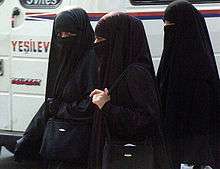Çarşaf

Çarşaf (Ottoman Turkish: چارشف) is a Turkish dress that completely hides the body, similarly to the niqab and the chador. Literally translated, çarşaf means "bed sheet".
The çarşaf is usually black. As with the Iranian chador, the çarşaf usually covers the lower part of the face, and the cloth is held together by a pin placed below the nose. Sometimes, the part of the cloth that covers the lower face is pinned laterally, as shown in the picture. In contrast to the chador, the çarşaf usually consists of two parts, a top that hangs to about the waist and a bottom that is cut like a wide, floor-length skirt.
The çarşaf, rather than being a form of traditional Islamic clothing, first became common towards the end of the 19th century, during the reign of Abdulhamid II (1876-1908), as a form of rejection of Western influences. From then, it continued to be used prevalently in remote parts of the former Ottoman Empire such as Yemen, where it is still widespread today.
According to a survey, only 0.1% of Turkish women wore the çarşaf in 2012.[1]
See also
References
- ↑ Fromm, Ali Çarkoğlu, Binnaz Toprak ; translated from Turkish by Çiğdem Aksoy (2007). Religion, society and politics in a changing Turkey (PDF). Karaköy, İstanbul: TESEV publications. p. 64. ISBN 978-975-8112-90-6.